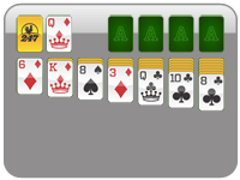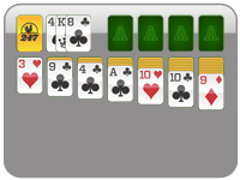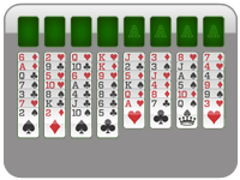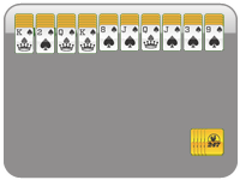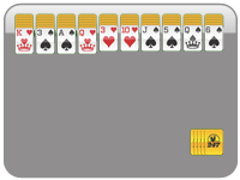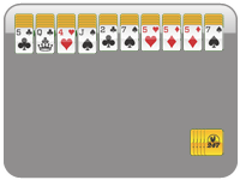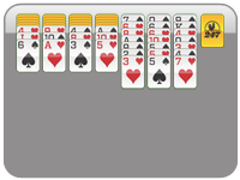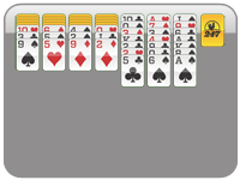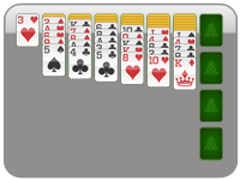Take it up a Notch with the Hardest Solitaire Game Around
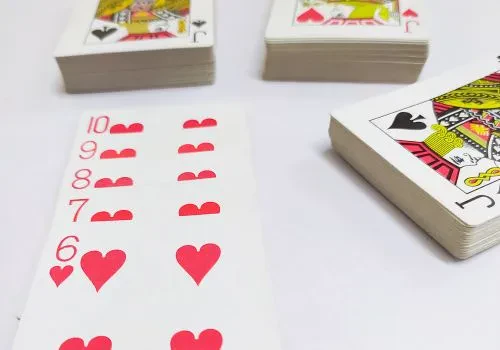
Introduction
Did you know that there are hundreds of different variations of Solitaire? While classic Solitaire provides a rewarding experience, it pales in comparison to the challenge of more difficult versions like Tripeaks Solitaire, 4-Suit Spider Solitaire, Scorpion Solitaire, and Russian Solitaire. If you're on the hunt for the hardest Solitaire game that will truly test your skills, these challenging variations are a perfect place to begin. Even for an experienced player, these options will push your limits!
What is solitaire?
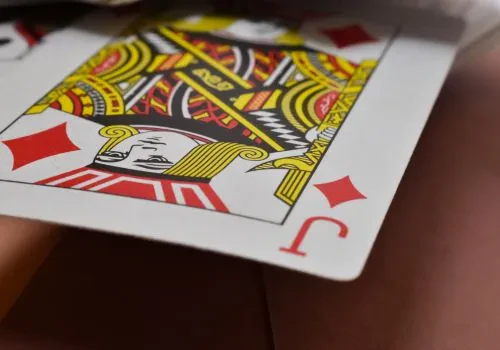
For the uninitiated, Solitaire is a game all about arranging a randomly sorted layout of cards into a series of corresponding stacks based on the suits (hearts, spades, clubs, diamonds) and colors of the cards.
The rules shift in minor and dramatic ways depending on the game, but the basic principle remains the same: counting and matching cards of similar types.
Gameplay
The most common type of Solitaire is called Klondike, and the goal of the game is to make four ascending stacks from ace to king in each of the suits. To play the Klondike version, you must lay out seven cards in a row with one face-up and the others face-down, increasing the number of face-down cards in each column by one from left to right.
These main playing stacks are known as the tableaus. In addition, you will also have some way to use the remaining cards. In Klondike, you will use the remaining cards as a draw pile, which we will call a stockpile. Klondike dictates that the player only draws one card, which fluctuates depending on the game.
To win, the player must then build up their four ascending stacks of each suit. To do so, the player must move around columns of cards and create sequences based on descending numbers and opposite colors. Let’s say that there’s an eight of clubs that you want to use. Because the eight of clubs is a black card, you would only be able to put a seven of hearts or diamonds under the eight of clubs. These stacks are known as the foundations, and they are vital to winning across all types of Solitaire.
Related: Solitaire Rules for Beginners: How to Get Started
Standard Solitaire variations
Klondike is among the easiest types of Solitaire to play, but there are many other options available. Here are some brief examples:
- 3 Card Klondike - In this variation on Klondike Solitaire, the player will draw three cards instead of one. One will then need to play each individual drawn card. That means if you can’t play the top card, the two under it cannot be used either. The player can then put the card in the waste pile, but it cannot be used again until the entire stockpile has been drawn.
- Freecell - Freecell Solitaire is one of the easiest Solitaire games. This version of Solitaire has more freedom and versatility because it has no hidden cards and there all cards are at your immediate disposal. True to its name, you are also given four free cells, which can be used as handy spaces to store single cards while organizing your tableau. The catch with the free cells is that you cannot store builds of more than one card inside these free cells
- Spider Solitaire—Named after the eight foundations that descend numerically according to their suit, like spider legs, Spider Solitaire is a challenging variation with a few changes in the movement of the cards.
- Wasp Solitaire - One of the more unique variations of Solitaire, this version of the game allows the player to interact and move any card across the board, even covered cards. The catch is that the first card of a stack must be one less than the card you’re placing it on top of.
- Scorpion Solitaire - Scorpion is almost identical to Wasp in its layout, but the twist is that the empty tableau spaces can only be played beginning with a king. The foundations are not arranged according to their suit, and they only need to be sorted to eliminate the tableau board.
Most difficult solitaire games
You’ve now read about a few different kinds of Solitaire and how they differ, but it hasn’t necessarily been specified why they’re difficult beyond having different rules.
What makes them challenging?
So, what makes some games of Solitaire more difficult? Broadly, it comes down to reducing choices and control. The hardest Solitaire games focus on limiting your options by restricting movement, adding randomness, eliminating winning paths, and testing your patience with difficult, often punishing, decisions. These elements combine to create some of the most difficult Solitaire games, and they offer a much more challenging experience compared to traditional versions.
5 Hardest Solitaire games
According to the website, Solitaired, these are the five types of Solitaire with the lowest win rate for players.
- Quadruple Yukon Solitaire - With a win rate of 2.36%, this massive variation of Yukon Solitaire tests players with four decks of cards, no stockpile, and all cards being placed in the tableau. The only saving grace is that you’re able to move cards around if they’re placed on a card of the opposite color and one rank higher.
- Las Vegas Solitaire - With a win rate of 2.45%, this version of Solitaire is particularly difficult because you only have one pass through the deck. And of course, this being a Vegas game, it’s all about wagering as the player wagers 52 total coins but earns five coins for every card moved to the foundation pile. Your goal is to make more money than you wagered, but the house always wins.
- Russian Solitaire - With a win rate of 3%, this Yukon variant has gained its reputation by only allowing movement of tableau cards with cards of the same suit and one rank higher therefore cutting the usual possible moves in half
- Double Russian Solitaire - With a win rate of 3.77%, two decks and an improved chance of winning is the only reason that this variation isn’t as difficult as others.
- Batsford Solitaire—With a win rate of 4.14%, this slightly easier variation has the same rules as Double Klondike Solitaire, except the player has a reserve pile exclusively for kings where you can sequence the cards.
4-Suit spider solitaire
Want to play some more of the hardest Solitaire games? We’ve got you covered starting with the difficult 4-Suit Spider Solitaire.
How to play
4-Suit Spider Solitaire is played with two decks of cards. The goal is to arrange all the cards in the tableau in descending order by suit, not just once but twice. When you successfully arrange a full sequence of cards from King to Ace in the same suit, those cards move to the foundation piles. During the game, you can stack a card on top of another card that’s one rank higher, regardless of the suit. The game is complete when all cards are organized into sequences by suit in the foundation.
Why it is difficult?
For starters, 4-Suit Spider Solitaire is already much more difficult than 1 or 2-suit Spider Solitaire because there are so many more possible combinations and possible moves. The cards are dealt randomly, and that means that you will need to constantly adapt to new layouts. Additionally, you will probably run into dead ends as you try to match every suit.
This version of Solitaire has strict rules for moving cards, making it more challenging. You must build sequences by suit, and one wrong move can block important cards or create a tricky situation! While you can place a single card on a higher-ranked card of a different suit, you cannot move a sequence if it contains cards from more than one suit. This can easily trap you between trying to build sequences and having your needed cards blocked.
Tips and tricks
There are a variety of strategies that one can employ to help with Spider Solitaire:
- Make sure to expose hidden cards as soon as possible. Hidden cards can make or break your game and as many cards as possible need to be revealed before you even think about touching the stockpile deck.
- Your stockpile should be a last resort. While it refreshes the tableau with a whole batch of fresh cards, it also further blocks your ability to interact with the hidden cards and sets you back. A good personal rule is that if you haven’t exhausted your moves, don’t take from the stockpile.
- Play to create stacks of the same suit or "natural" stacks. Make sure to keep each suit together as much as possible. Similarly, remember that you can focus on emptying a single column space to have a vacant tableau space to work with and organize your cards.
Related: How to Win 4 Suit Spider Solitaire: Tips and Strategies
Tripeaks solitaire
Or maybe you want to try your hand at Tripeaks Solitaire, which has a layout that resembles three mountain tops and presents entirely new problems to solve.
How to play
Unlike most other Solitaire games, Tripeaks Solitaire doesn’t have foundational piles. Instead, to play Tripeaks Solitaire, you will need to move every playing card from the tableau (arranged like peaks) to the waste pile. Then you will uncover cards from the tableau that are one number above or below the current card in the waste pile. The game is complete when you have destroyed all three peaks.
Here’s how to set up Tripeaks Solitaire:
- Start with three cards face-down for the tableau.
- Place two face-down cards underneath the first card and three more cards underneath them. The cards should slightly overlap the level above to form a triangle.
- Repeat Step 2 for the other two face-down cards.
- Build the last level of cards to connect the triangles. The last row of each pyramid should therefore contain four cards (12 in total). These cards connect the "peaks" of the name. Make sure that each of the cards on the last row are dealt face-up.
- All leftover cards should be set aside and will serve as your stockpile.
After that, to play the game, you will then move cards from the peaks of the tableau to the waste pile that are one number above or below the card played there.
Why it is difficult?
With its unique overlapping setup, Tripeaks Solitaire can be particularly tricky as it makes it harder to see potential moves and plan ahead. And along with that, the strict rules make it harder to find the exact cards you need to clear the peaks. Basically, you’re going to need some luck to win this one even if you’re careful with your game strategy.
Tips and tricks
The upside to Tripeaks Solitaire’s special arrangement is that you can approach it with different strategies than other games.
For instance, where other games require you to think about colors and fluid numerical sequences, the only thing that matters here is the number on the cards. Go lower or higher, it doesn’t matter as long as it helps to destroy those peaks.
Scorpion solitaire
For another different structural take on Solitaire, Scorpion will require you to view the game in an entirely new way.
How to play
In Scorpion Solitaire, you will build sequences of the same suit in descending order. But unlike Spider Solitaire, you may move around flipped cards on the tableau.
Here’s how to set up Scorpion Solitaire:
- Arrange seven stacks for the tableau. The first four stacks will have four face-down and three face-up cards. The other three stacks will have seven face-up cards. These last three stacks are where you’ll be moving cards to build sequences.
- Arrange your sequences in descending order from king down to ace in the same suit. When you complete a sequence, it’s removed from the tableau. As a side detail, you can move any flipped card to the next spot of a sequence, but you need to remember that the cards below it will follow.
Why is it difficult?
Well, frankly, this is just not going to be a game that you win very often. That’s because there are two major ways to be blocked in the course of the game:
- The first unique way to be blocked in Scorpion Solitaire is called a reverse sequence. This occurs when you have two cards in ascending order stacked on top of a card with a rank just one higher than the top card. For example, if you had a three of hearts on top of a two of hearts, and they were both on top of a four of hearts, it would create a tricky situation. You’d have to rearrange the cards in a challenging way to make the sequence work.
- The second way to get stuck is called a criss-cross. This is when two piles of cards have opposite needs. For example, If you have a nine of spades on the three of diamonds in one pile and the four of diamonds on the ten of spades in the other pile, then you’re going to need to find a way to untangle those. That’s when you should use empty spaces to break through these issues.
Tips and tricks
It’s not always recommended, but Scorpion Solitaire is the rare game where it’s a good idea to go to the stockpile if you want to reveal a few more cards.
But as with most games, it’s also important to reveal as many cards on the tableau as early as possible. That means you should focus on the four left stacks first before building out sequences. And if you can, try to just avoid situations like the criss-cross and reversed sequence.
Russian solitaire
If you want to completely eliminate any kind of stockpile or waste feature in your Solitaire game, you can also look into the Yukon variant, Russian Solitaire.
How to play
To play Russian Solitaire, you will arrange seven columns for the tableau.
- C1 - one card face-up
- C2 - one card face-down, five cards face-up
- C3 - two cards face-down, five cards face-up
- C4 - three cards face-down, five cards face-up
- C5 - four cards face-down, five cards face-up
- C6 - five cards face-down, five cards face-up
- C7 - six cards face-down, five cards face-up
In Russian Solitaire, you can move cards in the tableau on top of other cards only if it’s the same suit and one rank higher. You will rely exclusively on the tableau to move cards to the four foundation piles. In order to free up cards, sequence the cards by suit . The game is won when all cards have been moved from the tableau to the foundation piles.
Why is it difficult?
Like other Solitaire variations with strict rules and no stockpile possibilities, Russian Solitaire is difficult because you can easily run out of potential moves. And even moves that seem advantageous, like moving a card temporarily to free up another card above it will run into problems when you have to deal with all the cards attached to that stack.
Tips and tricks
Most strategies from other solitaire games apply here, such as revealing face-down cards as quickly as possible, focusing on clearing columns, and moving cards to the foundation piles. However, what makes this version unique is the limited space for movement. It's crucial not to get distracted by the last card in a sequence. For example, if a nine of clubs is available and the eight of clubs is visible, you should move it onto the nine, even if it’s buried behind several unrelated cards.
Alaska solitaire
If you’re looking to play a difficult Solitaire game with slightly less stringent rules, Alaska Solitaire is comparable to Russian Solitaire. However, it allows you to sequence in either ascending or descending order by suit, as opposed to only ascending.
How to play
As mentioned earlier, this game is very similar to Russian Solitaire, but there are more sequencing options. Like Russian Solitaire, there’s no waste pile or stockpile, and the main tableau still has 28 cards, with the remaining 24 cards dealt face-up.
In Alaska Solitaire, you can move the last card of each tableau pile to the foundation in ascending order by suit. Also, only Kings can be placed in empty tableau spaces. The main difference in this variant is that cards in the foundation can "wrap around," allowing you to place a King on top of an Ace, creating a continuous cycle.
Why is it difficult?
Alaska Solitaire adds an extra challenge because you cannot place an Ace on a King. In this difficult solitaire game, only a Queen of the same suit can be placed on a King. However, there is one helpful exception: you can place a Two on top of an Ace of the same suit.
Tips and tricks
To excel at Alaska Solitaire, there are a few key strategies to follow:
- Move Aces to the foundation piles quickly.
- Reveal face-down cards in the tableau as soon as possible.
- Delay moving other cards to the foundation until absolutely necessary.
However, Alaska Solitaire also requires different tactics compared to other solitaire games. In many variants, you can focus on the top cards for possible moves, but in this game, you’ll need to analyze entire columns to find hidden cards that can be moved as a group.
Keep challenging yourself
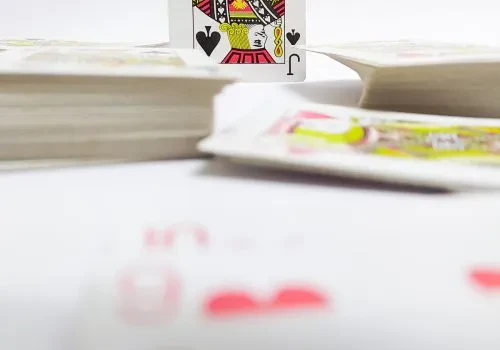
Even when things get tough, it’s important to challenge yourself. These are just a few examples of the many ways you can make your experience with solitaire more difficult and rewarding. When you push yourself with these more challenging games, you’re not just having fun—you’re also keeping your mind sharp and engaged.
If you want all the cards out in the open, play a game of Freecell. Or if you want to test your ability to handle two decks of cards, check out Spider Solitaire. Those choices are available to you as you learn how to master Solitaire.
Solitaire Games
More Solitaire Games
More Games
Solitaire News
Disclaimer
DISCLAIMER: The games on this website are using PLAY (fake) money. No payouts will be awarded, there are no "winnings", as all games represented by 247 Games LLC are free to play. Play strictly for fun.

